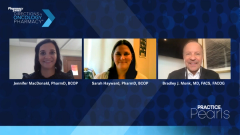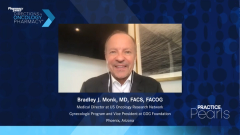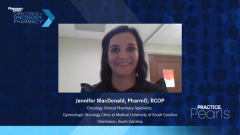
Practice Pearl 2: Role of Pharmacists in Overcoming Access Barriers in Ovarian Cancer
Bradley J. Monk, MD, FACS, FACOG, leads the discussion on the efficacy of currently approved PARP inhibitors used in the first-line maintenance setting for ovarian cancer and how pharmacists can help patients overcome access barriers.
Episodes in this series

Jennifer MacDonald, PharmD, BCOP: For completeness’ sake, what are the differences in PFS [progression-free survival] between all 3 PARP inhibitors? It’s a little confusing for people because there are so many different subsets of patients. Obviously, PAOLA and SOLO-1 are a little different as well.
Bradley J. Monk, MD, FACS, FACOG: I want to hear what Sarah has to say, but I don’t like to talk about PFS in a cross-trial comparison inference.
Jennifer MacDonald, PharmD, BCOP: Yes, we definitely can’t do that.
Bradley J. Monk, MD, FACS, FACOG: They all have very similar efficacy. You notice I didn’t. When I mentioned how you pick one over the other, we’re talking about copay, adverse reactions, once daily dosing, and drug interactions, just as Sarah said. I don’t think that way but suffice to say that in the HRD [homologous recombination deficiency] subset, there’s more than a doubling of the progression-free survival, and in the BRCA-mutated, there’s a tripling.
Jennifer MacDonald, PharmD, BCOP: Yes. That’s a very accurate way to represent it. Sarah, would you agree?
Sarah Hayward, PharmD, BCOP: I agree with that because it’s hard to compare head-to-head because they didn’t all necessarily look at the same populations. In SOLO-1, it was just the BRCA population. They didn’t look at all-comers like we did in PRIMA. It divides out from there. But consistently what we see across the board, whether it’s frontline maintenance or second-line maintenance, is that the BRCA mutation gets us significantly more progression-free survival. But we still see it with the HRD. We still see it in our all-comers in general and assorted other mutation lines that fit under the umbrella of homologous recombination deficiency.
Bradley J. Monk, MD, FACS, FACOG: Jen, you have the passion, too, right?
Jennifer MacDonald, PharmD, BCOP: Yes.
Bradley J. Monk, MD, FACS, FACOG: Our listeners need to know it’s not just us. We’re just following the NCCN [National Comprehensive Cancer Network] and ASCO [American Society of Clinical Oncology] guidelines. We’re trying to teach what the consensus guidelines say in another way. You’re probably pretty irresponsible if you don’t use a PARP inhibitor in a BRCA or HRD patient. It’s OK if you don’t do it, but you better say in the electronic medical record, “I talked to her.”
Jennifer MacDonald, PharmD, BCOP: Yes, that you discussed it.
Bradley J. Monk, MD, FACS, FACOG: Yes, that you mentioned that in PRIMA there’s a hazard ratio of 0.43 and a doubling of the PFS in the HRD subset, and that in PAOLA-1 the median PFS is 37.2 months, and that the patient doesn’t want that.
Jennifer MacDonald, PharmD, BCOP: Yes, definitely. Dr Monk, going back to something, when you talk about time points that you mentioned with when we’re starting it, we’re probably all thinking as soon as cycle 6 is done, “Can we send that prescription please to get it approved? And will they mention assistance or copay assistance or whatever it needs?” At that 3-week point when you want to start it, it’s not like, “We’re going to be delayed a week or 2 because other things need to happen or hoops need to be jumped through or paperwork needs to be signed.” We’re thinking, “Let’s prescribe it today in advance of when we’re going to need it so that when we do need it, it’s all lined up.” I assume that’s very similar to what you both recommend.
Sarah Hayward, PharmD, BCOP: Absolutely. Once we know that’s going to be our plan—to move on with an oral agent once a patient completes their primary IV [intravenous] chemotherapy—we get that going. For some patients, we can get it approved, ready, and with a $0 copay in less than 24 hours. For some patients, it takes a couple weeks. You have to get signatures, write a letter, and do this and that. The sooner, the better.
Bradley J. Monk, MD, FACS, FACOG: You guys are great. You’re literally where the rubber hits the pavement. It’s so good to hear what you’re saying. I have people like you in my practice, too. The other thing is, although not everyone does this, you have to set the expectation. I don’t ever want anybody to tell a patient that they’re going to get 6 doses of chemotherapy and everything is going to be over. Yesterday I had clinic and I saw a patient who had neoadjuvant [therapy]. I told her, “We’re going to give you 3 cycles of chemotherapy. It’s unresectable today. It will become resectable. We’ll do a surgery, 3 more cycles, and then we’re going to give you another better tolerated medication in maintenance to make sure it doesn’t come back, at least to the best of our ability.” And she was like, “OK.” Neoadjuvant is high-risk, and I believe they need bevacizumab [Avastin], but I hear you.
Jennifer MacDonald, PharmD, BCOP: Yes.
Sarah Hayward, PharmD, BCOP: Once you have that information that you can proceed with those medications, it also helps sometimes giving it to them a little at a time as you go through therapy.
Bradley J. Monk, MD, FACS, FACOG: Yes. That’s true, Sarah.
Sarah Hayward, PharmD, BCOP: Because sometimes if you start throwing it at them all at the beginning,
then you get to cycle 5 and say, “Remember we talked about what we were going to put you on,” and they go, “I don’t know what you’re talking about.” Keep in mind there’s a lot coming at them those first couple of visits, especially right after surgery and with initial diagnosis. That being said, I’ve had patients where I’ve sent in a prescription for a PARP inhibitor, and then all of a sudden the pharmacy calls them and says, “We have this new medication ready for you,” and the patient says, “I don’t know what you’re talking about.”
Bradley J. Monk, MD, FACS, FACOG: I always say, “We’re right on schedule. You’ve had 2 doses of chemotherapy and bevacizumab, the third dose there’s no bevacizumab. We’re right on schedule. We’re going to pick a date for your surgery today, and we’re going to get back on the chemotherapy and then we’re going to transition. You’re right on schedule, things are working just as I predicted. Your CA [cancer antigen] 125 was 3000 U/mL, now it’s 300 U/mL after 2—we’re right on schedule. Just stay in our lane. Stay on schedule. Work the plan. Solve the problem. Live your life. You’re going to get your life back after your 6 intravenous doses of chemotherapy. We’re going to get you through this surgery safely.” They love the confidence. The other thing is their support system. Their children, spouses, and sisters are so important in making the patient experience good.
Jennifer MacDonald, PharmD, BCOP: Yes, and that segues well into how we’re talking to patients. We’re very similar in talking to them throughout. It’s not like, wham, bam, “Here you go, we’re going to throw this on you.” Instead it’s, “Here’s the expectation all along of what we’re planning for you.”
Transcript Edited for Clarity
Newsletter
Stay informed on drug updates, treatment guidelines, and pharmacy practice trends—subscribe to Pharmacy Times for weekly clinical insights.








